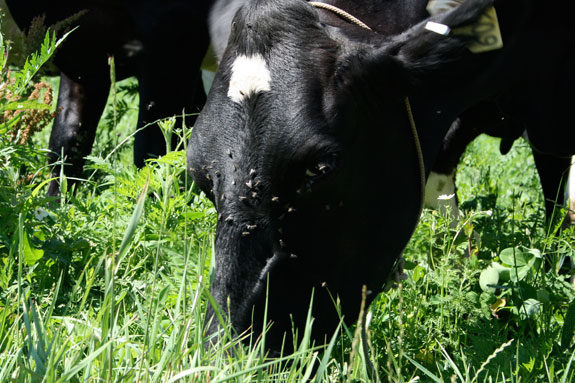It’s hot outside and that means pesky, profit-robbing flies. And if you haven’t already started on your fly control program for the year, you may be losing more than you bargained for, as flies are known to carry both animal and human diseases. Right now flies’ numbers are building rapidly as their generation time within manure and decaying feeds becomes increasingly shorter.
As reported in this publication and many others, the Department of Agriculture’s Grade A Pasteurized Milk Ordinance specifies the responsibility of dairy producers to conscientiously reduce fly populations on their farm. Dairy and health inspectors are becoming more conscientious of fly infestation on farms.
Many local governments have implemented laws to regulate fly control and manure management. In addition, the number of lawsuits relating to fly infestation from farms and the impact of flies on residential areas is growing.
Dairy producers and their residential neighbors are becoming more aware of the nuisance and potential for flies to transmit dangerous diseases.
Lost profitability
The actual monetary loss from fly infestation is difficult to measure, but estimates from various studies (including Purdue, Cornell and the University of Tennessee) range from 10 percent to 20 percent decline in milk production when dairy cows are heavily infested with biting flies.
There are several factors veterinarians and university researchers attribute to this growing cost for dairy producers including:
- Attempts by the cow to alleviate irritation from biting and sucking flies increase maintenance requirements, which impact feed efficiency for milk production.
- Shaking-off motions, biting, rubbing and tail switching, which all increase heart and respiratory rates. An increase in body temperature is especially detrimental when the cow is also stressed by environmental heat.
- Fly populations naturally increase during warm temperatures; differentiating between heat stress or parasite infestation or both may be difficult when a drop in milk production occurs.
- Nutrient demand increase as a direct response to blood loss. When the blood-feeding fly population is significant enough to cause the cow’s body to divert nutrients into replacing lost blood, milk production may suffer.
- Transmission of disease among cows by external parasites is yet another potential cause for reduced milk production.
- Flies transmit diseases including anthrax, brucellosis and tuberculosis, as well as Staphylococcus and Streptococcus mastitis infections. Mastitis bacteria can live up to 16 hours in a fly, which is more than enough time to transmit the bacteria from cow to cow.
Sanitation should be and is the most effective part of the fly control program. Sanitation involves:
- Removing manure frequently during the day.
- Hauling manure to fields or frequently pumping from lagoons.
- Cleaning up spilled feed immediately.
- Keeping bedding clean and dry.
- Filling mud holes or any low spots in lots where water can accumulate.
Control and prevention
As with any pesticide, if a product is “not cleared for direct animal use,” don’t apply it to an animal. Products cleared for premise sprays can adversely affect an animal if not specifically labeled for use on the animal.
There are spray-on products that are labeled for “direct animal use” and, of course, dust/pour-on products can also be applied directly to the animal.
Sprays – Insecticide animal sprays can be either oil-based or water-based. Water dilutable sprays are more effective for high-volume application, especially when power equipment is used. Common, effective insecticides such as permethrin, dichlorvos and tetrachlorvinphos are effective and economical.
Dust bags – Dust bags use powdered insecticides and should be placed at the exit lane of parlors. To be effective, bags should hang four to six inches below the top line of the cattle. Same insecticide compounds found in sprays are also effective in dusts. Additionally, coumaphos is readily used and is highly effective.
Back and face rubbers – Oil-based insecticides are used in back or face rubbers. Cows should get an application of the insecticide at least twice daily. Placing oilers in the exit lane of parlors is most effective.
Foggers – Space sprays or foggers kill flies on contact.
Premise sprays – Residual properties of these sprays enable them to be used effectively as premise sprays. Sprays should be applied to areas where flies hide, such as calf hutches, feed spill areas, stalls, pens, feed bunks and hospital or maternity pens.
Ear tags – Ear tags can be a highly effective, highly cost-effective method of fly control when chemical insecticide resistance is not a problem. With the introduction of endosulfan ear tags approved on lactating dairy cows, dairy producers can control biting flies for up to five months for less than $5 per head. Rotation between insecticide classes (i.e., endosulfan to diazinon) is also suggested.
Baits – Baits contain an ingredient to attract flies and an active ingredient that kills flies once the bait is consumed. Fly bait can be an effective method to kill houseflies.
Feeding to improve fly control – Rabon, a feed-through larvicide, is a proven effective means to prevent the breeding of horn flies in the manure of treated cattle and costs only pennies per head per day.
Horn flies are especially detrimental to cattle on pasture or anywhere manure is not disturbed for several days. For a lactating dairy cow with 1,000 flies, the resulting 4,000 to 8,000 bites daily can cause an estimated 20 percent drop in milk production.






